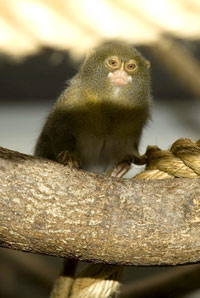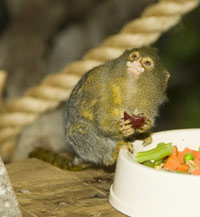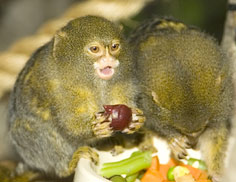|

 A more primitive primate: Most marmosets are about 20 cm in length. The pygmy marmoset is the smallest living monkey. Relative to other monkeys, they show a number of apparently primitive features: they have claws rather than nails, and tactile hairs on their wrists. They lack wisdom teeth, and their brain layout seems to be relatively primitive. Their body temperature is unusually variable, showing as much as 4 Celsius degrees (7 Fahrenheit degrees) change in a day. A more primitive primate: Most marmosets are about 20 cm in length. The pygmy marmoset is the smallest living monkey. Relative to other monkeys, they show a number of apparently primitive features: they have claws rather than nails, and tactile hairs on their wrists. They lack wisdom teeth, and their brain layout seems to be relatively primitive. Their body temperature is unusually variable, showing as much as 4 Celsius degrees (7 Fahrenheit degrees) change in a day.
Limited to Brazil: The Common marmoset (Callithrix (Callithrix) jacchus) is a New World monkey. It originally seemed to only live on the northeast coast of Brazil. It was recently found also in southeast Brazil.
The fur of the Common Marmoset is gray. The most distinguishing characteristic is the white, tufts of hair which surround the ears, which lend it another common name, the Cotton Eared marmoset. A white mark is on the forehead and the face is hairless. The long tail is gray-white. Common marmoset adult size ranges from 14 to 18 cm and they weigh approximately 400 g.

Active, high up, gum harvests: Marmosets are highly active, living in the upper canopy of forest trees, and feeding on insects, fruit and leaves. They have long lower incisors, which enable them to chew holes in the trunks or branches of trees so as to harvest the gum inside; some species are specialized feeders on gum.
Family Marmoset: Marmosets live in small family groups consisting of a mated pair and their offspring, thus making marmosets (along with gibbons) some of the few monogamous primates. They are thought to be territorial. In most species, twins are usually born, though triplets are not unknown. A high degree of paternal care is shown, and the male usually carries the infants on his back as the family group moves around.
Day jumpers: Like all callitrichines, Common marmosets are diurnal. Their habitat ranges from the edge of forests into the deep forests, but they also appear in fields. They can run  swiftly along the branches of trees and are also excellent jumpers. swiftly along the branches of trees and are also excellent jumpers.
Strict Ranks: Common marmosets live together in family groups of four to 15 animals, usually mated adults and their offspring. These groups inhabit territories of 300,000 square meters. The groups have a strict ranking, ordered by the dominance and aggressive behavior of the group leader.
Diet delicacies: The diet of the Common marmoset consists of insects, spiders, small vertebrates, bird eggs and tree sap.

Different relationship systems: Common marmosets have variable mating systems: monogamous,
polygamous and polyandrous. All adults and subadults share in the care
of the young. 
Mostly twins! After an approximately 150-day gestation, the female
typically gives birth to twins, though up to four offspring have been
observed in captive settings (larger litters suffer higher mortality
rates). Compared to adults, the young animals are very large. Newborn
twins together are 20 percent to 27 percent of the body weight of the
mother, and it is assumed that the cooperative care of young helps
counter some of the high costs of raising twin offspring. Males can
mate after about one year, while females aren't fully mature until
about 20 to 24 months.
The life expectancy of the Common marmosets in the wild is about 10 years, although some living in captivity have lived to 16 years.
The Pygmy Marmoset lives in social groups up to about 15.
Lots of helpers:
There is a breeding pair, plus offspring. Even as the offspring get older -some reaching adulthood, they may stay in the group without breeding. Instead they (and the father) will help raise the young.

- Subgenus Callithrix - Atlantic marmosets
- Common Marmoset, Callithrix (Callithrix) jacchus
- Black-tufted Marmoset, Callithrix (Callithrix) penicillata
- Wied's Marmoset, Callithrix (Callithrix) kuhlii
- White-headed Marmoset, Callithrix (Callithrix) geoffroyi
- Buffy-headed Marmoset, Callithrix (Callithrix) flaviceps
- Buffy-tufted Marmoset, Callithrix (Callithrix) aurita
- Subgenus Mico - Amazonian marmosets
- Rio Acari Marmoset, Callithrix (Mico) acariensis
- Manicore Marmoset, Callithrix (Mico) manicorensis
- Silvery Marmoset, Callithrix (Mico) argentata
- White Marmoset, Callithrix (Mico) leucippe
- Emilia's Marmoset, Callithrix (Mico) emiliae
- Black-headed Marmoset, Callithrix (Mico) nigriceps
- Marca's Marmoset, Callithrix (Mico) marcai
- Black-tailed Marmoset, Callithrix (Mico) melanura
- Santarem Marmoset, Callithrix (Mico) humeralifera
- Maués Marmoset, Callithrix (Mico) mauesi
- Gold-and-white Marmoset, Callithrix (Mico) chrysoleuca
- Hershkovitz's Marmoset, Callithrix (Mico) intermedia
- Satéré Marmoset, Callithrix (Mico) saterei
- Subgenus Callibella - Roosmalens' Dwarf Marmoset
- Roosmalens' Dwarf Marmoset, Callithrix (Callibella) humilis
- Subgenus Cebuella - Pygmy Marmoset
- Pygmy Marmoset, Callithrix (Cebuella) pygmaea
Baboon | Howler Monkey | Lion Tamarin | Mandrill | Patas Monkey | Squirrel Monkey
Primates| Apes| Monkeys| Prosimians
All text is available under the terms
of the GNU Free Documentation License
|